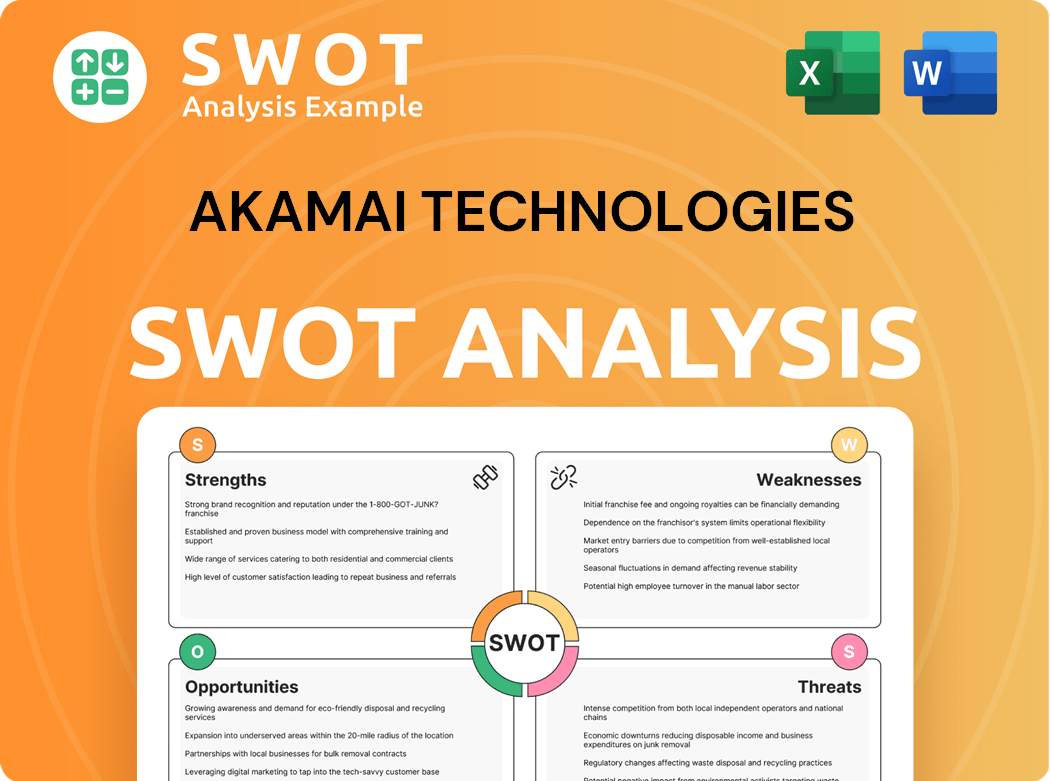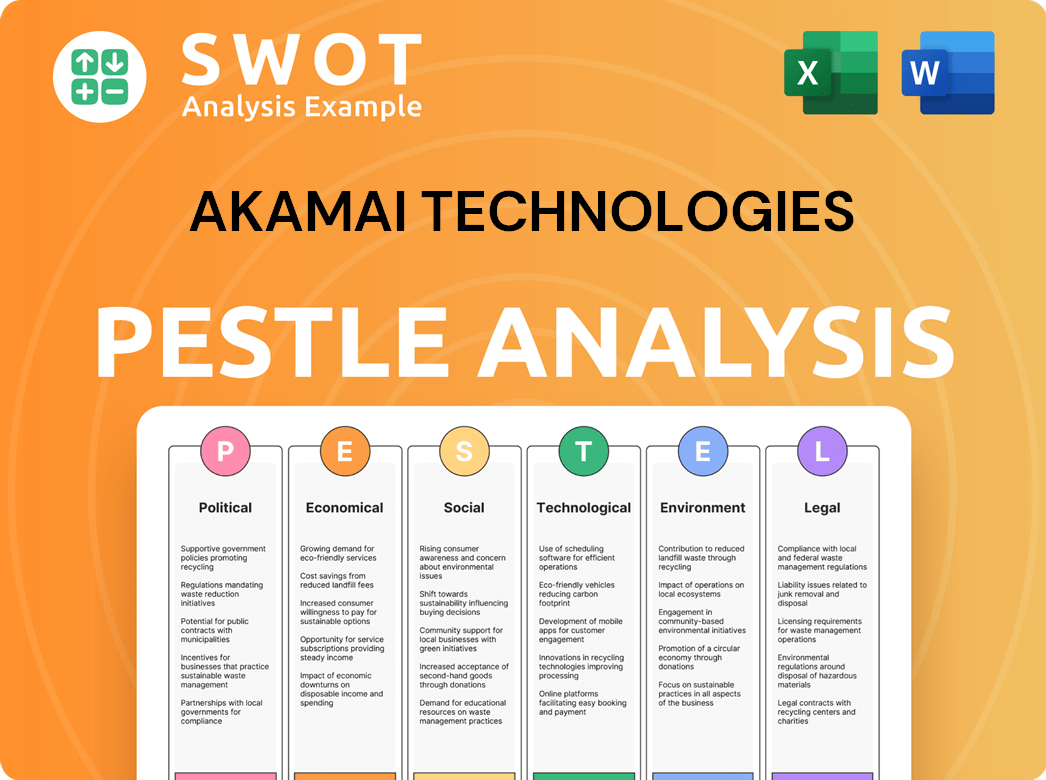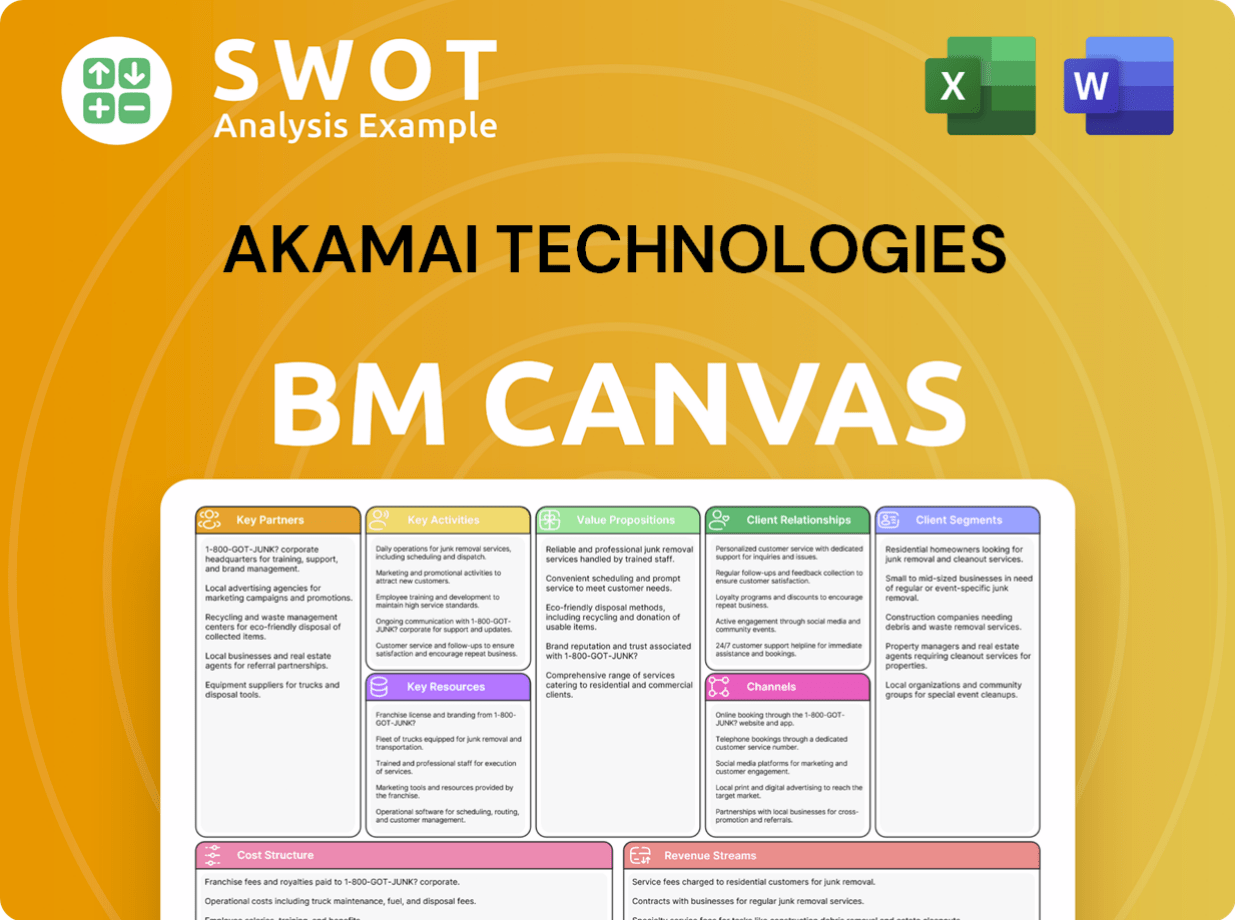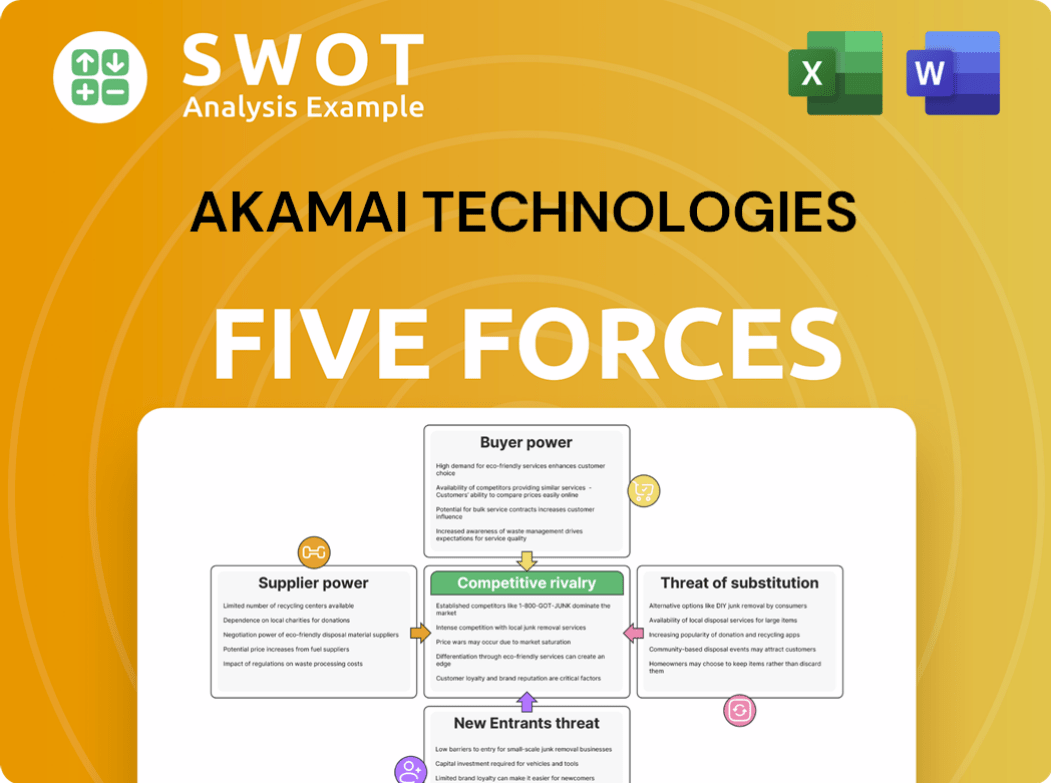Akamai Technologies Bundle
How Did Akamai Technologies Revolutionize the Internet?
From its humble beginnings addressing internet congestion, Akamai Technologies has become a cornerstone of the digital world. Its story is one of innovation, starting with a challenge from the creator of the World Wide Web himself. Founded in 1998, Akamai's journey from a research project to a global leader in Akamai Technologies SWOT Analysis is a fascinating look at how technology shapes our lives.

This article delves into the brief history of Akamai Technologies, exploring its founding and evolution as a leading CDN provider. We'll examine the early days of this Internet infrastructure giant, tracing its growth from a solution for content delivery to a comprehensive provider of cybersecurity and cloud services. Discover how Akamai company has consistently adapted to the ever-changing demands of the digital landscape, cementing its place as a vital part of the internet.
What is the Akamai Technologies Founding Story?
The story of Akamai Technologies, a leading content delivery network (CDN) provider, began in 1998. This Akamai Technologies founding was driven by a need to solve the growing problem of internet congestion.
The company's roots are firmly planted in academic research conducted at the Massachusetts Institute of Technology (MIT). This research would lay the foundation for a company that would revolutionize how content is delivered across the internet.
Akamai Technologies was incorporated on August 20, 1998. The founders included Professor F. Thomson Leighton and graduate student Daniel Lewin, along with Randall Kaplan and Jonathan Seelig. Their work aimed to address the challenges of internet performance.
Akamai's founding was a direct response to the increasing issue of internet congestion, a challenge highlighted by Tim Berners-Lee in 1995. The company's innovative approach to content delivery stemmed from mathematical algorithms developed at MIT.
- F. Thomson Leighton, an expert in parallel algorithms, and Daniel Lewin developed the core technology.
- The name 'Akamai,' a Hawaiian word meaning 'intelligent' or 'clever,' reflects the company's innovative approach.
- Preetish Nijhawan also played a key role in the early stages.
- The company's initial prototype and incorporation followed their participation in the 1998 MIT $50K Entrepreneurship Competition.
Akamai Technologies SWOT Analysis
- Complete SWOT Breakdown
- Fully Customizable
- Editable in Excel & Word
- Professional Formatting
- Investor-Ready Format

What Drove the Early Growth of Akamai Technologies?
The early years of Akamai Technologies were marked by rapid growth and strategic expansion. The company quickly gained traction after its commercial launch in April 1999, securing major clients and handling significant online events. This period saw the company establish its presence as a leading CDN provider and internet infrastructure innovator.
One of the first major clients for Akamai was Yahoo!, a significant endorsement at the time. The company delivered its first live traffic in February 1999, starting with a small element on the Disney website. Akamai gained early exposure by managing traffic for high-profile events like ESPN's March Madness and a Star Wars trailer for Entertainment Tonight, showcasing its ability to handle high user demand.
Akamai went public on the NASDAQ Stock Market on October 29, 1999, raising over $200 million in a successful IPO. By 2000, Akamai's global network had expanded to over 15,000 servers across more than 1,300 networks in 70 countries. This expansion enabled faster and more reliable content delivery worldwide, solidifying its position in the content delivery network market.
In 2002, Akamai launched EdgeSuite, a more advanced product that combined dynamic traffic control with enhanced security features and support for streaming media. Strategic acquisitions, such as Speedera Networks in 2005, strengthened their position. Leadership transitions included George Conrades as CEO in April 1999, Paul Sagan in 2005, and Tom Leighton taking over in 2013.
During its early years, Akamai's financial performance was closely watched by investors. The IPO in 1999 was a significant financial milestone, providing capital for further expansion. While specific financial details from the early 2000s vary, the company's growth trajectory and strategic moves reflect its ambition to become a dominant player in the content delivery space. The company's revenue in 2000 was approximately $50 million, demonstrating its early success.
Akamai Technologies PESTLE Analysis
- Covers All 6 PESTLE Categories
- No Research Needed – Save Hours of Work
- Built by Experts, Trusted by Consultants
- Instant Download, Ready to Use
- 100% Editable, Fully Customizable

What are the key Milestones in Akamai Technologies history?
The story of Akamai Technologies is marked by significant milestones, from its inception to its current standing as a major player in internet infrastructure. The Akamai company has consistently adapted and evolved, shaping the landscape of content delivery and cybersecurity. Its journey reflects a blend of technological innovation, strategic acquisitions, and responses to market dynamics.
| Year | Milestone |
|---|---|
| 1998 | Akamai Technologies was founded by Tom Leighton and Danny Lewin, originating from research at MIT focused on solving internet congestion. |
| 1999 | Akamai had a successful IPO, marking a significant step in its growth and expansion. |
| 2001 | The company was added to the Russell 3000 and Russell 2000 Indexes, reflecting its growing market presence. |
| 2004 | Akamai achieved its first profitable year, a crucial turning point in its financial stability. |
| 2007 | The company joined the S&P 500 index, solidifying its position among leading companies. |
| 2012 | Akamai launched Kona Site Defender, expanding its offerings into cloud-based web security. |
Akamai Technologies has been at the forefront of innovation in internet infrastructure. A key early innovation was its distributed network architecture and intelligent algorithms, which revolutionized content delivery. More recently, the company has focused on emerging technologies, introducing products like Firewall for AI and Managed Container Service.
This was a foundational innovation, distributing content across a global network of servers to improve speed and reliability. This architecture significantly improved the user experience by reducing latency and ensuring content availability.
Akamai developed algorithms to optimize content delivery based on network conditions and user location. These algorithms dynamically route traffic, ensuring efficient content delivery.
Launched in 2012, this marked Akamai's expansion into cloud-based web security, offering protection against various online threats. This product helped secure websites and applications against DDoS attacks and other malicious activities.
This product reflects Akamai's focus on emerging technologies, providing security solutions tailored for AI applications. It helps secure AI workloads and data against evolving cyber threats.
This service supports the deployment and management of containerized applications, enhancing flexibility and scalability. It allows businesses to efficiently manage and scale their applications in the cloud.
Akamai has invested in edge computing, bringing compute resources closer to end-users. This reduces latency and improves application performance, especially for real-time applications.
Despite its successes, Akamai has faced several challenges. The death of co-founder Daniel Lewin in the September 11 attacks was a profound loss. The company has also navigated intense competition in the CDN provider market and broader cloud services landscape.
Akamai competes with major players like AWS, Microsoft Azure, and Google Cloud Platform, intensifying the need for innovation and strategic differentiation. These competitors offer a wide range of services, putting pressure on Akamai's market share.
Akamai has experienced declining revenue in its traditional content delivery segment, requiring a shift towards high-growth areas like security and compute. This shift is critical for sustaining growth and adapting to changing market demands.
The Akamai company operates in a rapidly evolving market, influenced by technological advancements and economic fluctuations. Adapting to these changes requires continuous investment and strategic agility.
The increasing sophistication of cyber threats poses a constant challenge, requiring Akamai to continually enhance its security offerings. This includes developing new products and services to protect against emerging threats.
Economic downturns can impact spending on internet infrastructure and security services, affecting Akamai's financial performance. The company must manage costs and adapt to changing customer needs during economic uncertainty.
Akamai has used acquisitions to expand its capabilities and customer base, but integrating these acquisitions can present challenges. Successful integration is crucial for realizing the full value of these strategic moves.
To learn more about the company's core values, mission, and vision, you can read the article Mission, Vision & Core Values of Akamai Technologies.
Akamai Technologies Business Model Canvas
- Complete 9-Block Business Model Canvas
- Effortlessly Communicate Your Business Strategy
- Investor-Ready BMC Format
- 100% Editable and Customizable
- Clear and Structured Layout

What is the Timeline of Key Events for Akamai Technologies?
The Akamai Technologies journey began in 1998, quickly becoming a key player in internet infrastructure. The company's evolution includes significant milestones, from its initial public offering in 1999 to its expansion through strategic acquisitions and product launches, solidifying its position as a leading CDN provider.
| Year | Key Event |
|---|---|
| 1998 | Akamai Technologies is incorporated, marking its founding. |
| 1999 | The company launches its commercial service and has a successful IPO. |
| 2001 | Co-founder Daniel Lewin dies in the 9/11 attacks, and the company is added to the Russell 3000 and Russell 2000 Indexes. |
| 2002 | Launches EdgeSuite product. |
| 2004 | Posts its first profit. |
| 2005 | Paul Sagan becomes CEO, and the company acquires Speedera Networks. |
| 2007 | Added to the S&P 500 index. |
| 2012 | Launches Kona Site Defender. |
| 2013 | Co-founder Tom Leighton becomes CEO. |
| 2019 | Celebrates its 20th anniversary. |
| 2022 | Acquires Linode for $900 million, expanding cloud computing capabilities. |
| 2024 | Acquires Noname Security for $450 million and select customer contracts from Edgio. |
| 2025 | Reports Q1 revenue of $1.015 billion. |
Akamai is focusing on cybersecurity and cloud computing. Security revenue is projected to grow by approximately 10%, and compute revenue is expected to increase by about 15% in constant currency for 2025. These segments are key drivers for future growth.
The delivery segment is expected to see a further decline in 2025. However, Akamai is seeing improvements in the marketplace with more multiyear contracts and stable pricing. The company is adapting to evolving market conditions.
Akamai is investing in AI security and cloud services, launching new products in these areas. These investments are designed to strengthen its market position and provide innovative solutions. This focus is crucial for long-term success.
The company forecasts full-year 2025 revenue between $4.05 billion and $4.20 billion. Analyst projections for Akamai's stock price in 2025 vary, with an average target around $98.1. These figures reflect the company's expected performance and market sentiment.
Akamai Technologies Porter's Five Forces Analysis
- Covers All 5 Competitive Forces in Detail
- Structured for Consultants, Students, and Founders
- 100% Editable in Microsoft Word & Excel
- Instant Digital Download – Use Immediately
- Compatible with Mac & PC – Fully Unlocked

Related Blogs
- What is Competitive Landscape of Akamai Technologies Company?
- What is Growth Strategy and Future Prospects of Akamai Technologies Company?
- How Does Akamai Technologies Company Work?
- What is Sales and Marketing Strategy of Akamai Technologies Company?
- What is Brief History of Akamai Technologies Company?
- Who Owns Akamai Technologies Company?
- What is Customer Demographics and Target Market of Akamai Technologies Company?
Disclaimer
All information, articles, and product details provided on this website are for general informational and educational purposes only. We do not claim any ownership over, nor do we intend to infringe upon, any trademarks, copyrights, logos, brand names, or other intellectual property mentioned or depicted on this site. Such intellectual property remains the property of its respective owners, and any references here are made solely for identification or informational purposes, without implying any affiliation, endorsement, or partnership.
We make no representations or warranties, express or implied, regarding the accuracy, completeness, or suitability of any content or products presented. Nothing on this website should be construed as legal, tax, investment, financial, medical, or other professional advice. In addition, no part of this site—including articles or product references—constitutes a solicitation, recommendation, endorsement, advertisement, or offer to buy or sell any securities, franchises, or other financial instruments, particularly in jurisdictions where such activity would be unlawful.
All content is of a general nature and may not address the specific circumstances of any individual or entity. It is not a substitute for professional advice or services. Any actions you take based on the information provided here are strictly at your own risk. You accept full responsibility for any decisions or outcomes arising from your use of this website and agree to release us from any liability in connection with your use of, or reliance upon, the content or products found herein.